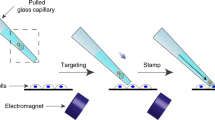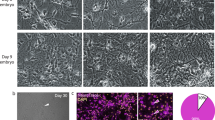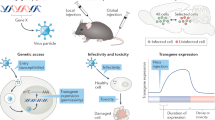Abstract
Efficient and long-lasting transfection of primary neurons is an essential tool for addressing many questions in current neuroscience using functional gene analysis. Neurons are sensitive to cytotoxicity and difficult to transfect with most methods. We provide a protocol for transfection of cDNA and RNA interference (short hairpin RNA (shRNA)) vectors, using magnetofection, into rat hippocampal neurons (embryonic day 18/19) cultured for several hours to 21 d in vitro. This protocol even allows double-transfection of DNA into a small subpopulation of hippocampal neurons (GABAergic interneurons), as well as achieving long-lasting expression of DNA and shRNA constructs without interfering with neuronal differentiation. This protocol, which uses inexpensive equipment and reagents, takes 1 h; utilizes mixed hippocampal cultures, a transfection reagent, CombiMag, and a magnetic plate; shows low toxicity and is suited for single-cell analysis. Modifications done by our three laboratories are detailed.
This is a preview of subscription content, access via your institution
Access options
Subscribe to this journal
Receive 12 print issues and online access
$259.00 per year
only $21.58 per issue
Buy this article
- Purchase on Springer Link
- Instant access to full article PDF
Prices may be subject to local taxes which are calculated during checkout





Similar content being viewed by others
References
Jiang, M. & Chen, G. High Ca2+-phosphate transfection efficiency in low-density neuronal cultures. Nat. Protoc. 1, 695–700 (2006).
Watanabe, S.Y. et al. Calcium phosphate-mediated transfection of primary cultured brain neurons using GFP expression as a marker: application for single neuron electrophysiology. Neurosci. Res. 33, 71–78 (1999).
Kim, J.B. et al. Enhanced transfection of primary cortical cultures using arginine-grafted PAMAM dendrimer, PAMAM-Arg. J. Control. Rel. 114, 110–117 (2006).
Tonges, L. et al. Stearylated octaarginine and artificial virus-like particles for transfection of siRNA into primary rat neurons. RNA 12, 1431–1438 (2006).
Goetze, B., Grunewald, B., Baldassa, S. & Kiebler, M. Chemically controlled formation of a DNA/calcium phosphate coprecipitate: application for transfection of mature hippocampal neurons. J. Neurobiol. 60, 517–525 (2004).
Zeitelhofer, M. et al. High-efficiency transfection of mammalian neurons via nucleofection. Nat. Protoc. 2, 1692–1704 (2007).
Plank, C. et al. The magnetofection method: using magnetic force to enhance gene delivery. Biol. Chem. 384, 737–747 (2003).
Chudotvorova, I. et al. Early expression of KCC2 in rat hippocampal cultures augments expression of functional GABA synapses. J. Physiol. 566, 671–679 (2005).
Lardi-Studler, B. et al. Vertebrate-specific sequences in the gephyrin E-domain regulate cytosolic aggregation and postsynaptic clustering. J. Cell Sci. 120, 1371–1382 (2007).
Baer, K. et al. PICK1 interacts with alpha7 neuronal nicotinic acetylcholine receptors and controls their clustering. Mol. Cell Neurosci. 35, 339–355 (2007).
Sassoe-Pognetto, M. & Fritschy, J.M. Mini-review: gephyrin, a major postsynaptic protein of GABAergic synapses. Eur. J. Neurosci. 12, 2205–2210 (2000).
Kim, J.H., Liao, D., Lau, L.F. & Huganir, R.L. SynGAP: a synaptic RasGAP that associates with the PSD-95/SAP90 protein family. Neuron 20, 683–691 (1998).
Chen, H.J., Rojas-Soto, M., Oguni, A. & Kennedy, M.B. A synaptic Ras-GTPase activating protein (p135 SynGAP) inhibited by CaM kinase II. Neuron 20, 895–904 (1998).
Paradis, S. et al. An RNAi-based approach identifies molecules required for glutamatergic and GABAergic synapse development. Neuron 53, 217–232 (2007).
Brunig, I., Scotti, E., Sidler, C. & Fritschy, J.M. Intact sorting, targeting, and clustering of gamma-aminobutyric acid A receptor subtypes in hippocampal neurons in vitro. J. Comp. Neurol. 443, 43–55 (2002).
Brunig, I., Suter, A., Knuesel, I., Luscher, B. & Fritschy, J.M. GABAergic terminals are required for postsynaptic clustering of dystrophin but not of GABA(A) receptors and gephyrin. J. Neurosci. 22, 4805–4813 (2002).
Xia, Z., Dudek, H., Miranti, C.K. & Greenberg, M.E. Calcium influx via the NMDA receptor induces immediate early gene transcription by a MAP kinase/ERK-dependent mechanism. J. Neurosci. 16, 5425–5436 (1996).
Jacquier, A. et al. Alsin/Rac1 signaling controls survival and growth of spinal motoneurons. Ann. Neurol. 60, 105–117 (2006).
Kawai, H., Zago, W. & Berg, D.K. Nicotinic alpha 7 receptor clusters on hippocampal GABAergic neurons: regulation by synaptic activity and neurotrophins. J. Neurosci. 22, 7903–7912 (2002).
Terashima, A. et al. Regulation of synaptic strength and AMPA receptor subunit composition by PICK1. J. Neurosci. 24, 5381–5390 (2004).
Rubinson, D.A. et al. A lentivirus-based system to functionally silence genes in primary mammalian cells, stem cells and transgenic mice by RNA interference. Nat. Genet. 33, 401–406 (2003).
Kim, M.J., Dunah, A.W., Wang, Y.T. & Sheng, M. Differential roles of NR2A- and NR2B-containing NMDA receptors in Ras–ERK signaling and AMPA receptor trafficking. Neuron 46, 745–760 (2005).
Schrader, N. et al. Biochemical characterization of the high affinity binding between the glycine receptor and gephyrin. J. Biol. Chem. 279, 18733–18741 (2004).
Xia, J., Zhang, X., Staudinger, J. & Huganir, R.L. Clustering of AMPA receptors by the synaptic PDZ domain-containing protein PICK1. Neuron 22, 179–187 (1999).
Acknowledgements
We thank Grigory Krapivinsky (Harvard Medical School, Boston) for help with preparing of shRNA coding vector. We are grateful to Corinne Sidler, Susanne Erb-Vögtli and Dubravka Göckeritz-Dujmovic (University of Zürich) for excellent technical assistance. This study was supported by grants from the Swiss National Science Foundation (to C.F. and J.-M.F.), the Swiss Foundation for Research on Muscle Diseases (to C.F.), INSERM (to C.P. and I.M.) and the French Foundation for Medical Research (to I.C.).
Author information
Authors and Affiliations
Corresponding author
Rights and permissions
About this article
Cite this article
Buerli, T., Pellegrino, C., Baer, K. et al. Efficient transfection of DNA or shRNA vectors into neurons using magnetofection. Nat Protoc 2, 3090–3101 (2007). https://doi.org/10.1038/nprot.2007.445
Published:
Issue Date:
DOI: https://doi.org/10.1038/nprot.2007.445
This article is cited by
-
Towards translational optogenetics
Nature Biomedical Engineering (2022)
-
Ca2+/Calmodulin-Dependent Protein Kinase II (CaMKII) β-Dependent Phosphorylation of GABAB1 Triggers Lysosomal Degradation of GABAB Receptors via Mind Bomb-2 (MIB2)-Mediated Lys-63-Linked Ubiquitination
Molecular Neurobiology (2019)
-
Molecular architecture of potassium chloride co-transporter KCC2
Scientific Reports (2017)
-
Electrophysiological assessment of primary cortical neurons genetically engineered using iron oxide nanoparticles
Nano Research (2017)
-
g-force induced giant efficiency of nanoparticles internalization into living cells
Scientific Reports (2015)
Comments
By submitting a comment you agree to abide by our Terms and Community Guidelines. If you find something abusive or that does not comply with our terms or guidelines please flag it as inappropriate.



